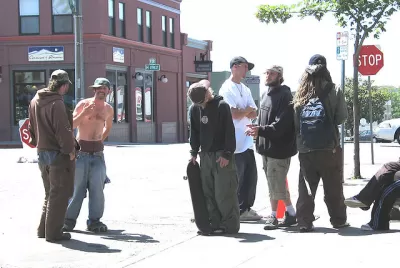The Northern California city of Arcata has long tolerated the production of California's most second-most-lucrative mood-altering crop. Now, the city is considering an official zoning designation to accommodate marijuana production.

They don't call it the "Emerald Triangle" for nothing. Emerald has long referred to the lush forests of California's north coast, and, more recently, to its profusion of black-market marijuana production. Lately, though, green has referred to cash—the roughly $1.4 billion that the commercial marijuana industry, operating on the fringes of legality, has brought to the region. Statewide, the weed industry is estimated to be worth $31 billion annually, compared to $51 billion for wine.
With potentially hundreds of growers, producers, and chefs operating within its city limits, the hippie-friendly city of Arcata has taken steps to become the first city in the country to regulate, and accommodate, not only pot dispensaries (which are legal for consumers of medical marijuana in California) but also production facilities. The logic, say some city officials, is clear: give producers a proper, safe place to operate, and they won't invade neighborhoods or, worse, create dangerous, unsanitary products.
Arcata's city council has taken preliminary steps to create a "Medical Marijuana Innovation Zone," which could be implemented by the end of the year. It could potentially accommodate indoor growers and producers of edibles, among others. This move hearkens back to the origins of zoning, by which cities segregated noxious uses from everyday folks. If the industry continues to grow, the zoning could serve as a model for other cities in pot-friendly states and give Arcata a leg up if Californians vote to legalize recreational marijuana, as it might next year via a ballot measure.
"City officials say the power of zoning offers its best, and perhaps only, tool for regulating the marijuana industry, which otherwise depends on decisions at the state level. Arcata-based attorney Mark Harris, advisor to the National Organization for Reform of Marijuana Laws (NORML) says he considers the zone an 'overwhelmingly positive' development. He sees this approach as a model not only for cities throughout California but also for those in other pot-friendly states."
"It’s refreshing to see local authorities recognizing that their communities will benefit economically by welcoming the transition of this already lucrative cash crop from criminal hands to tax-paying, job-creating, law-abiding businesses," says "Radical" Russ Belville, a Portland, Oregon-based radio host and marijuana activist.
FULL STORY: California City Moves Toward Innovation Zone for Marijuana

Alabama: Trump Terminates Settlements for Black Communities Harmed By Raw Sewage
Trump deemed the landmark civil rights agreement “illegal DEI and environmental justice policy.”

Planetizen Federal Action Tracker
A weekly monitor of how Trump’s orders and actions are impacting planners and planning in America.

The 120 Year Old Tiny Home Villages That Sheltered San Francisco’s Earthquake Refugees
More than a century ago, San Francisco mobilized to house thousands of residents displaced by the 1906 earthquake. Could their strategy offer a model for the present?

In Both Crashes and Crime, Public Transportation is Far Safer than Driving
Contrary to popular assumptions, public transportation has far lower crash and crime rates than automobile travel. For safer communities, improve and encourage transit travel.

Report: Zoning Reforms Should Complement Nashville’s Ambitious Transit Plan
Without reform, restrictive zoning codes will limit the impact of the city’s planned transit expansion and could exclude some of the residents who depend on transit the most.

Judge Orders Release of Frozen IRA, IIJA Funding
The decision is a victory for environmental groups who charged that freezing funds for critical infrastructure and disaster response programs caused “real and irreparable harm” to communities.
Urban Design for Planners 1: Software Tools
This six-course series explores essential urban design concepts using open source software and equips planners with the tools they need to participate fully in the urban design process.
Planning for Universal Design
Learn the tools for implementing Universal Design in planning regulations.
Clanton & Associates, Inc.
Jessamine County Fiscal Court
Institute for Housing and Urban Development Studies (IHS)
City of Grandview
Harvard GSD Executive Education
Toledo-Lucas County Plan Commissions
Salt Lake City
NYU Wagner Graduate School of Public Service




























